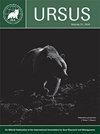高速公路对亚洲黑熊遗传多样性的影响
IF 0.6
4区 生物学
Q4 ZOOLOGY
引用次数: 4
摘要
摘要/ Abstract摘要:熊类栖息地破碎化是全球熊类面临的主要威胁,尤其是道路的修建成为了熊类传播的屏障。2012-2015年,我们采用非侵入性毛发取样研究了泰国Dong Phayayen-Khao Yai森林复群中亚洲黑熊(Ursus thibetanus)的遗传多样性。我们使用了9个微卫星位点来调查居住在被高速公路分隔了60年的综合体两侧的黑熊。在考艾和东法延分别鉴定出49个个体(雄性31个,雌性18个)和45个个体(雄性25个,雌性20个)。东Phayayen的遗传多样性水平与Khao Yai相似;两个种群分化程度较低(fst = 0.035),没有明显的近交证据(FIS分别为0.13和0.07)。然而,考崖和东法延之间的FST(分别为0.035和0.038)明显高于东法延内部的FST(0.004),表明高速公路对种群的影响明显,目前两林之间的迁移率为1%。因此,这条路显然是黑熊的一个重要的分散屏障。这个种群具有保护意义,因为估计的有效种群规模(Ne = 178只熊)低于黑熊的推荐规模。亚洲黑熊相对较长的一代时间可能是造成高速公路铺设与种群间遗传多样性变化之间时间差的主要因素。我们的模拟表明,在接下来的10代中,高速公路对这个群体的遗传产生了强烈的负面影响,如果继续隔离,灭绝的风险就会增加。我们的数据还表明,通过栖息地走廊的辅助迁徙计划可以减少这条高速公路的影响,并促进熊的持久性。本文章由计算机程序翻译,如有差异,请以英文原文为准。
Effects of a highway on the genetic diversity of Asiatic black bears
Abstract: Bears are globally threatened by habitat fragmentation, particularly due to roads, which can act as dispersal barriers. We used noninvasive hair sampling to study the genetic diversity of Asiatic black bears (Ursus thibetanus) in the Dong Phayayen–Khao Yai forest complex, Thailand, during 2012–2015. We used 9 microsatellite loci to investigate black bears inhabiting 2 sides of the complex that have been separated by a highway for 60 years. We genetically identified 49 individuals (31 males and 18 females) in Khao Yai and 45 individuals (25 males and 20 females) in Dong Phayayen. The genetic diversity level of Dong Phayayen was similar to Khao Yai; low differentiation (F ST = 0.035) and no strong evidence of inbreeding was indicated for both populations (FIS = 0.13 and 0.07, respectively). However, the pairwise FST between Khao Yai and Dong Phayayen was notably higher (FST = 0.035 and 0.038, respectively) than within Dong Phayayen (0.004), suggesting an observable effect of the highway on the populations, with a current migration rate of 1% between the 2 forests. Thus, the road apparently acts as a significant dispersal barrier for the black bear. This population is of conservation concern because the estimated effective population size (Ne = 178 bears) was below the recommended size for black bears. The relatively long generation time of Asiatic black bears could be the main factor contributing to the time lag between placement of the highway and changes in genetic diversity between the populations. Our simulations indicated a strong negative impact of the highway on the genetics of this population within the next 10 generations and an increased risk of extinction if there is continued isolation. Our data also suggest that an assisted migration program via habitat corridors could reduce the impact of this highway and promote the persistence of bears.
求助全文
通过发布文献求助,成功后即可免费获取论文全文。
去求助
来源期刊

Ursus
生物-动物学
CiteScore
2.00
自引率
15.40%
发文量
12
审稿时长
>12 weeks
期刊介绍:
Ursus includes a variety of articles on all aspects of bear management and research worldwide. Original manuscripts are welcome. In addition to manuscripts reporting original research, submissions may be based on thoughtful review and synthesis of previously-reported information, innovative philosophies and opinions, and public policy or legal aspects of wildlife conservation. Notes of general interest are also welcome. Invited manuscripts will be clearly identified, but will still be subject to peer review. All manuscripts must be in English. All manuscripts are peer-reviewed, and subject to rigorous editorial standards.
 求助内容:
求助内容: 应助结果提醒方式:
应助结果提醒方式:


